.gif) |
The word "conjugate" means "to join
together," and combining multiple methods within a
single workout can lead to a stronger, faster, more
well-balanced body.
By Greg Werner,
M.S., CSCS, SCCC, ACSM-HFI, CSNC
For
athletes, performance and the prevention of injury--not
aesthetics--should be the motivation for strength
training, since a nice-looking physique will come as a
by-product of hard work. With this being said, it's
upsetting to see how many athletes still refer to the
popular body-building magazines for their strength
training advice. Strength training for athletic
performance needs to be purpose-driven, and that purpose
depends upon the needs of the sport, not the desire for
a particular body part to look a certain way.
For
the majority of sports, I have determined that there are
four truths when considering strength training and
sports performance:
1) In all sports that
involve athleticism (speed, strength, power, agility,
mobility) athletes who can produce and reduce high force
at high speed are at an advantage.
2) Speed of
movement, strength, and explosive power are related;
athletes with higher power to body weight ratios execute
faster, and dominate athletics.
3) Just building
big muscles, lifting heavy weights, or doing Olympic
lifts is not good enough; you need to implement several
methods of training to optimally develop sports
performance.
4) By doing the proper lifts, jumps,
and sprints, you will increase the horsepower of your
vehicle--which is your body.
From the perspective
of these truths we can see that athletes cannot just
depend on heavy strength training alone. They need to be
involved in a program that implements a complete regimen
of muscle actions (concentric, eccentric, isometric),
training speeds, and intensities. And that's where
conjugate training comes in.
What is conjugate
training? Conjugate means to join together. To train
using multiple methods within one workout, or over the
course of one block of workouts (microcycle). Strength,
power, hypertrophy, speed, and agility can be
progressively developed simultaneously in a conjugate
multi-method program.
The most fundamental
components of a strength training program are the amount
of weight lifted (overload) and the speed of the
repetition (tempo). Vladimir Zatsiorsky, Ph.D.--a
world-renowned strength scientist, author, and professor
at Penn State University--determined that there are
three distinct methods for developing force within
skeletal muscle fibers. These three methods are
responsible for overloading the fast twitch muscle
fibers (type IIa and IIb) innervated by the fast motor
units (fast oxidative glycolitic, and fast fatigable). I
call this "Targeted Overload," and the methods
are:
Maximum Effort:
Maximal Strength
(strong reps)
Heavy training, using 85-100 percent of a one rep
max (1RM)
Dynamic Effort:
Explosive
Strength (speed reps)
Explosive training, using sub-max weights at max
speed
Plyometrics--stretch shortening cycle (SSC)
activities
Speed and agility training
Repetitive
Effort:
Hypertrophy Strength (burn reps)
Training to a point of muscular fatigue using
sub-max weights
Lactate tolerance training
Work capacity training

Max-effort training is
used to develop the high threshold fast-twitch muscle
fibers. But be careful, attempting to lift weights that
are too heavy is counterproductive. Athletes should
never attempt to lift weights that are so heavy that
someone else has to lift it off of them, or that cause
them to use poor technique to force the weight up. Below
is a sample max effort cycle:
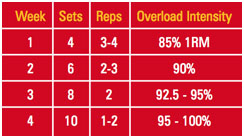
The next
method of overload--"dynamic effort" training--is used
to activate your fast twitch muscle fibers in an
explosive manner. When using this method of overload the
rate of force development (bar speed) is key. The weight
should not be heavy in comparison to the max effort day.
Rate of force development, your body's ability to
recruit motor units and fire muscles, is what you're
training. Below is a sample dynamic effort cycle:
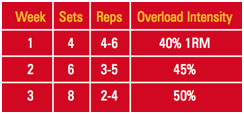
The last
method of overload, "repetitive effort," is used to push
the muscles to produce force in a fatigued state. The
athlete's muscles should experience a burning on the
last few reps of the set. It's important not to take the
sets to complete failure, but rather to a point of
fatigue, one to two reps short of total failure. When
you get to the point of failure, exercise technique
generally becomes sloppy. Below is a sample repetitive
effort cycle:
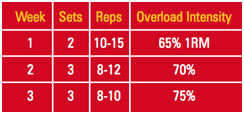
Cycling/Periodization
You
can't train the same exercises with weights above 90
percent for much longer than three weeks before your
nervous system begins to weaken. When this happens
strength gains will begin to diminish and accumulative
fatigue will cause the athlete to plateau. For this
reason training must be cycled with fluctuations in
exercise selection, intensity, and volume
(periodization). The best way around this three-week
barrier is to switch the exercises used for the max
effort method every one to three weeks. This keeps the
body fresh so the method can be cycled year round. Below
are the guidelines for cycling:
Keep all workouts between four to six total
exercises.
Do only one max effort workout per week for the
upper body and one for the lower body primary strength
exercises (i.e., squat, deadlift, bench press, pull-ups,
rows).
Do one dynamic effort workout per week for the upper
body and one for the lower body primary strength
exercises (i.e., squat, power clean, bench press,
pull-ups, rows).
Use the repetitive effort method for your
supplemental and auxiliary exercises every workout
(i.e., sled pulls, shoulder and rotator cuff work,
triceps, bicep, forearms and abs).
Take an active rest week after every three max
effort cycles (12 weeks) to allow for complete
restoration (i.e., cross train and play another sport,
get out of the weight room but don't just sit
around).
Stop repetitive effort sets one to two reps short of
complete muscle failure. This assures the athlete will
always use good lifting technique and not overtax the
muscles.
Here's the intensity progression for the
three methods together for a four-week period.
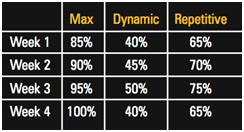
To build their
best body, athletes need to do multi-joint strength
training exercises with the collective goal of
developing muscle mass, strength, and power.
Multi-Joint Exercises
The first thing
you must help athletes grasp and believe is this; the
body is one functional unit. If you isolate and train
one muscle group and neglect others you develop
imbalances, which can eventually lead to injury. For
optimal sport performance the body must be trained as an
athletic machine, one that functions as the collective
sum of its parts.
There's a saying in athletic
strength and conditioning that it's better to train
movements and not just muscles. The nature of most
sports is to make ground based, multi-joint movements
and not isolated single-joint movements. With this in
mind strength training should be specific and follow
suit.
In the weight room isolating your
quadriceps (leg extensions), hamstrings (leg curls),
glutes (hip extensions), and calves (heel raises) is
isolated muscle building, whereas using ground based,
multi-joint exercises such as squats, dead lifts, and
hang cleans are movement building. Movement building
activates the neuromuscular system in similar firing
patterns as it's called upon in sport, and therefore has
a greater transfer to athletic performance. Below is a
list of the most useful multi-joint exercises:
Upper body:
Bench presses (flat, incline, decline)
Pull-ups
Chin-ups
Pulldowns
Rows (bent over, seated, and upright)
Shoulder presses (military and behind the neck)
Lower/Total body:
Squats (deep, parallel, half squats, front squats,
lunges, split squats)
Dead lifts (conventional, sumo, Romanian, good
morning)
Olympic lifts (cleans, jerks, snatches)
In order
to take their performance to the next level, athletes
must start by taking their strength training to the next
level. Cycle the three methods of overload with
multi-joint exercises, and consume the right foods at
the right times, followed by adequate rest, and they'll
be well on their way to a stronger, more-athletic body.
Train them hard, and most importantly train them smart.
About the author:
Greg Werner
is director of strength and conditioning at James
Madison University, and owner of AthElite Strength &
Conditioning Academy.
|
References:
Vladimir M. Zatsiorsky, 1995, Science and Practice
of Strength Training, Human Kinetics.
Mel Siff and Yuri V Verkhoshansky, 1999, Super
Training: Strength Training for Sporting Excellence. 4th
edition, Supertraining International.
John Ivy and Robert Portman, 2004, Nutrient Timing
System, Basic Health.
| |
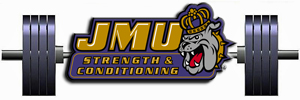 Official
Site of the James Madison University Strength & Conditioning Program
Official
Site of the James Madison University Strength & Conditioning Program